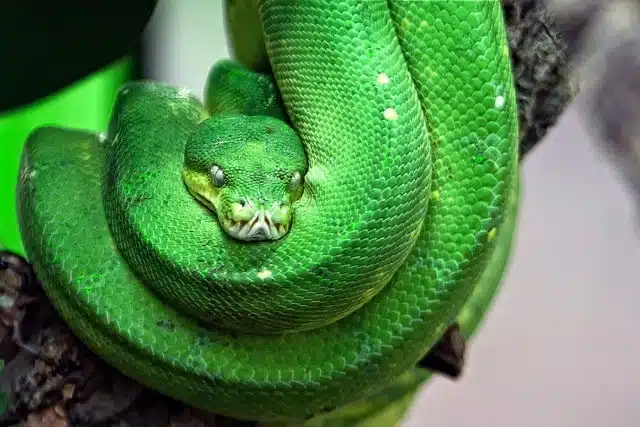Welcome to our article about the top 10 scariest green animals.
You’ve definitely seen some green animals, haven’t you? Green is a color mostly connected with Nature, bringing luxuriant trees, forests, and grasses to mind. Sometimes green can be synonymous with serenity and tranquillity, and perhaps this is why the color is closely associated with good health and energy.

Of course, in many public places, green is usually a sign of safety [think traffic lights and emergency exits]. However, green doesn’t always indicate safety or comfort in the animal kingdom, and some green animals can be downright scary, if not deadly.
Some creepy-looking animals with green coloration are lethally dangerous. Some look cute and inviting but are terribly venomous. While others just don the terrifying appearance to deter predators and be left alone.
For many of these animals, green outer surfaces are the only way to blend into the environment and survive.
In any case, most green animals can usually move around unnoticed around their typical habitats. Yet, when you do notice the scary ones, you notice them. They are captivating and hard to ignore.
Be advised, however, to only approach at your own risk. You might have discovered a new pet companion or an emergency trip to the hospital.
Scariest Green Animals
If you know your way around animals, especially wild ones, no animal is truly scary because you will know their capabilities well enough to avoid them. However, a lot of us do not and can run a risk of fatal injury.
Summarily, it would be of little surprise to many that our list is populated with reptilians. This class of animals includes some of the most feared animal species after all. But also scary and sometimes dangerous to humans are some green insects and amphibians. Let’s take a look at ten of these awe-inspiring and thrilling creatures.
10. Sloths
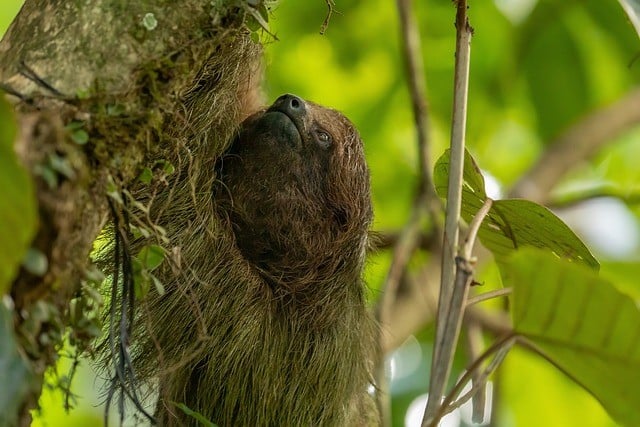
Sloths get their name from their characteristic slow and sedentary lifestyle. Even the word ‘sloth’ literally translates to lazy. When you think about slow-moving animals, perhaps snails and tortoises come to mind, but the sloth takes it to another level.
Wild snails have a top speed of 0.05km/hr, while sloths move ten times slower at 0.005km/hr. This makes them the slowest animals in the world.
Although they may look scary, these arboreal creatures are gentle animals who survive by feeding on leaves and algae. Their slow movement serves as an adaptation to prevent them from predators like hawks and big cats in the jungle.
The sloth’s fur is light brown; however, their unhurried movement allows green algae to grow on it, making them appear like green animals. This algal growth is also symbiotic because it helps them blend into the trees and avoid being seen by predators.
9. Agapostemon
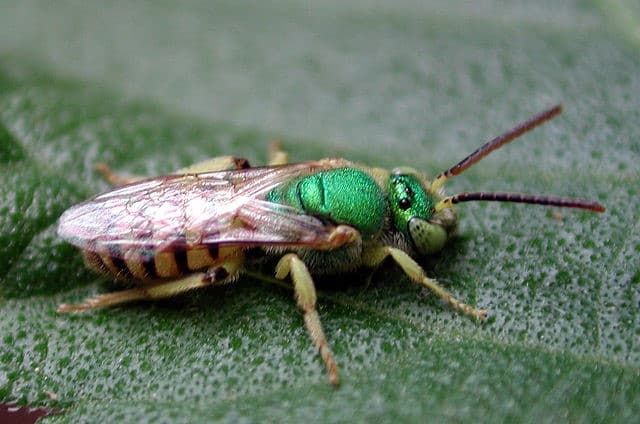
Commonly known as green metallic sweat bees, agapostemons are one of those green animals you are likely to come across in your everyday life. They are found across the Western Hemisphere, as far north as Canada and south to Argentina.
What’s more? You don’t need to venture into zoos to see them. They will actively seek you out if you’ve got the juice they are after. These insects are attracted to human sweat, and the salt from it provides them with nutrition. However, they are primary nutrition remains pollen and nectar from flowers.
If you see these bees buzzing around your arms or neck, you may assume they intend to sting or harm you. But some of these bees are so lightweight that they can sometimes drink the sweat off your skin without you even realizing it.
However, don’t mistake this for being docile. These bees can sting and deliver painful bites when alarmed or provoked. Female members of the species are green all over, but males are probably more recognizable, having metallic green heads and thorax, with black and yellow bands around their abdomen.
8. Emerald Tree Boa
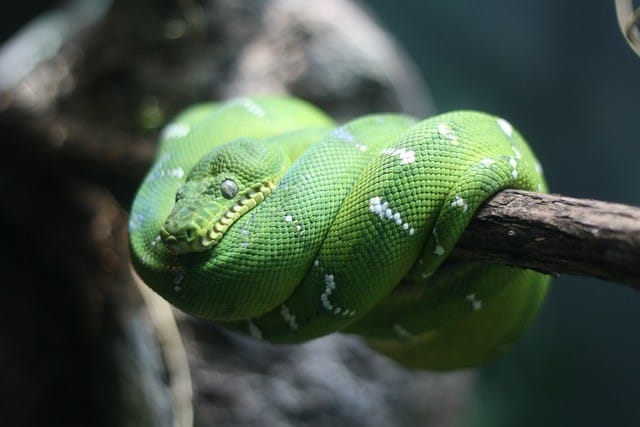
The emerald tree boa is a snake species native to the tropical rainforest of South America. They are known to grow up to 1.8m in length, and their unique green colors and markings make them easily distinguishable from other South American snakes.
Though these snakes are non-venomous, you certainly might not think that if you were to encounter one. They hunt their prey by ambush and constriction. Living primarily on trees, their diet consists of small birds, mammals, and marsupials.
Emerald tree boas are ovoviviparous reproducers. Unlike other snakes, they carry and hatch their eggs internally and then give birth to live young, sometimes up to fifteen.
These young juveniles are born with a red to orange coloration but grow into their emerald green color. Also, the green coloration becomes fully pronounced at 12 months, though sexual maturity is not reached till three to four years.
7. Green Tree Python
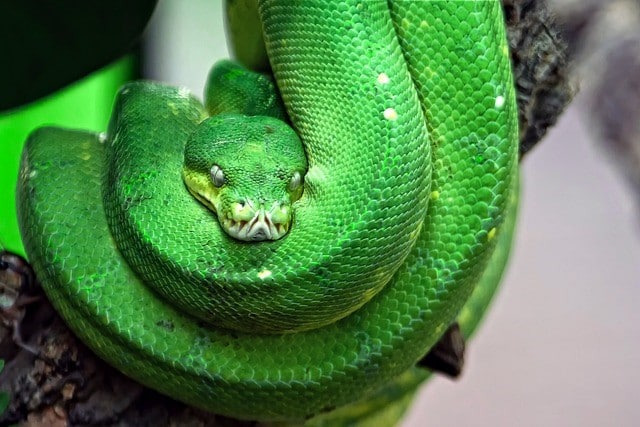
The green tree Python is an arboreal snake native to the islands of New Guinea, Indonesia, and Australia. A distant evolutionary cousin of the emerald tree boa, both species share many strikingly similar physical attributes, including their characteristic resting pose.
In contrast to the emerald tree boa, the green tree python is oviparous, laying eggs, protecting, and incubating them till they hatch. Also, the young hatchlings are born lemon-yellow with brown spots. Even though these snakes are constrictors with a mildly irritable temperament, they are still widely haunted and captured for sale by illegal pet traders.
Along with the emerald boa, their striking green colors make them a coveted species among reptile breeders. This has greatly dwindled their wild population, but the green tree python is still considered of Least Concern in terms of species endangerment.
6. Green And Black Poison Dart Frog
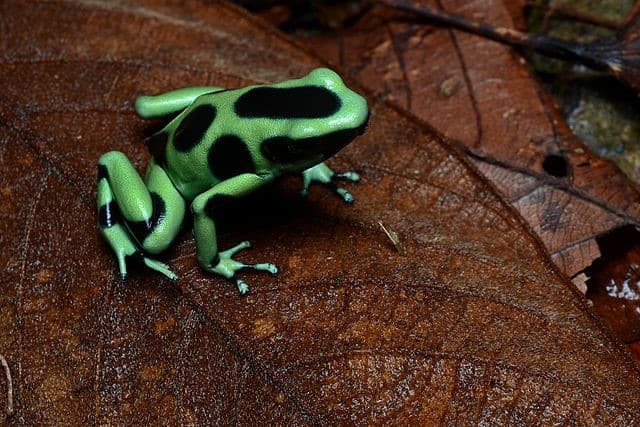
Although it may not hold the ultimate title of most poisonous frog, the green and black poison dart frog is similar to other dart frogs in that the poison it secretes from its skin is highly toxic. They are arboreal frogs found in trees in the forest of Central America and northern South America.
Their common name is derived from their appearance, which is a typical mint green with splotches of black. Also, the poison on their skins is used by local tribes to fashion poisonous darts used in hunting. This poison is so potent it is enough to stop regular cardiovascular function in humans within minutes of coming into contact with it.
Even though they sound intimidating, these green animals make intriguing pets and are very popular among wild pet traders because of their distinctive colors.
This is possible because when in captivity, their poison loses toxicity. This has been reported to result from changes in diet and environment because much of their poison is accumulated from the venomous insects they feed upon in the wild.
5. Komodo Dragons
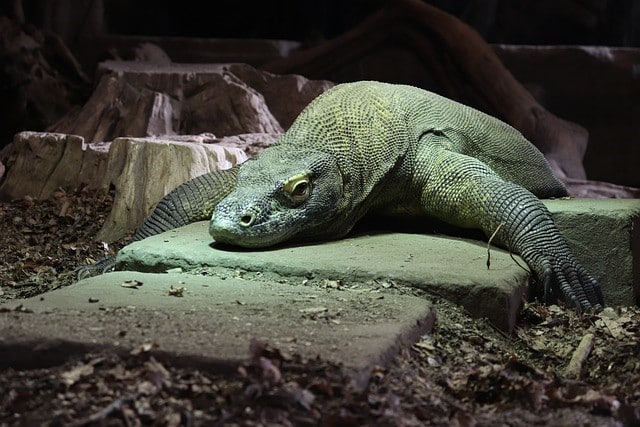
Dubbed the king of lizards, komodo dragons are the largest living species of lizard in the world, growing up to 10ft and weighing up to 70kg. These fearsome creatures are apex predators in their endemic ecosystem, which includes the Indonesian islands of Komodo [hence the name] Flores, Rinca, and Gilli Montana.
Their diet includes birds, mammals, carrion, and small reptiles, but their natural prey is the Timor deer, found abundantly in Indonesia. Komodos can also sometimes be cannibalistic. Adult komodos may feed on younger ones when food is scarce, so young komodos tend to live on trees where adults can’t climb because of their size.
These green animals have poisonous saliva, and even when the komodo unsuccessfully tries to hunt prey, a bite is deadly enough to kill the prey soon after.
Komodo Dragons have tough and durable hides ranging from black to green to yellow-gray. This skin is reinforced with bony plates to protect them from injuries and infections. On the Indonesian islands where they are found, komodos are known to dig up human corpses from shallow graves, and they may also attack humans if they feel they are cornered.
4. Boomslang
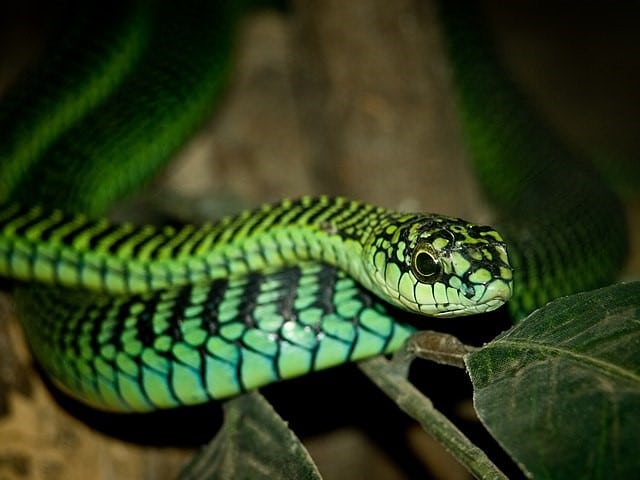
These green reptiles grow up to six feet and are endemic to sub-Saharan Africa. Boomslang literally translates to tree snake in the Afrikaans and Dutch languages. But don’t allow this simple name to make you think they are cuddly.
These arboreal green animals are highly poisonous. Their potent venom is known to cause tissue hemorrhage in the muscles and brain, leading to headaches, nausea, mental disorders, and other pathophysiological symptoms.
What makes these animals even scarier is that their venom is slow-acting, and victims may think the snake who bit them is non-venomous, giving them a false sense of assurance. If not immediately treated with antivenom, this can soon lead to death.
Although male boomslang hatchlings are born grey with blue speckles and females with pale brown colorations, males attain their green color after several years while the female remains brown [a form of sexual dimorphism].
Another reason you should be wary of boomslangs is that they are not restricted to trees. They would often seek warmth around human houses when the weather is harsh.
3. Western Green Mamba
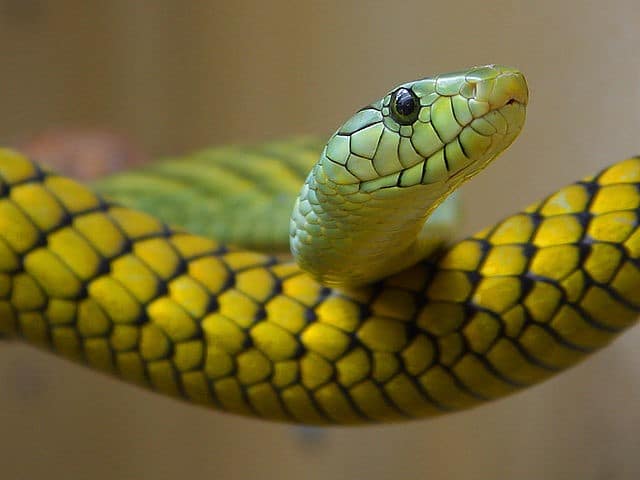
There are two popular species of green mambas, the eastern green mamba and the western green mamba. The western green mamba beat its eastern counterpart to the number three spot. That’s because its venom is more potent and deadly. These graceful green animals are shy but agile enough to move swiftly across trees.
They mainly inhabit the tropical rainforest of West Africa and can grow up to 8ft long. However, because they are timid reptiles, encounters with humans are usually rare. But the few reported cases are almost always fatal. Their venom contains fast-acting neurotoxins and cardiotoxins that can cause cardiac arrest and paralysis within a few hours.
Western green mambas are bright green with yellow or orange colors around the tapered end of their tail. They can sometimes be mistaken for boomslangs because they inhabit the same region.
2. Green Anaconda
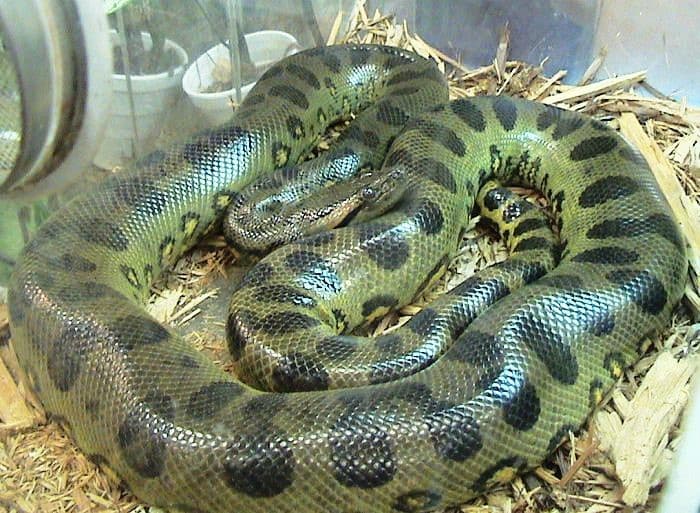
This animal is also known as the giant Anaconda or common Anaconda. The green Anaconda is a non-venomous constrictor snake in the boa family. It can grow up to 30ft long and weigh up to 250kg. Making it the heaviest existing snake species in the world.
These enormous green animals are native to South America. They are found east of the Andes mountains in Brazil, Bolivia, Colombia, Ecuador, Peru, and Venezuela. They favor swamps and marsh environments in the Amazon and Orinoco basins, where they can remain stealthy underwater.
Anacondas are primarily nocturnal creatures and spend most of their lives in or around water. Also, these olive-green animals reach their highest speeds when swimming. Their head and snout are located on the top of your head to allow them to submerge their body when laying an ambush.
They are ovoviviparous snakes and can sometimes give birth to up to 100 live offspring. These large snakes can feed on large animals like tapirs, caimans, and capybaras half their size.
Sometimes, however, they can resort to cannibalism if food is scarce. Female anacondas have been reported to eat smaller males.
Though technically, Anacondas can prey on humans, there have not been any verified reports of this, perhaps because anacondas live in environments not typically inhabited.
1. Crocodiles
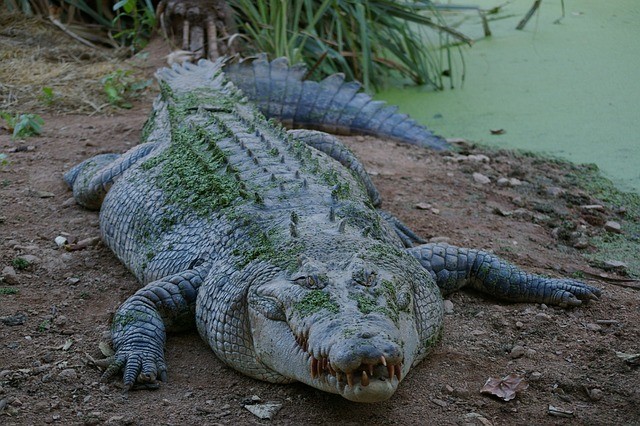
Crocodiles are semi-aquatic reptiles found in tropical climates of Africa, Asia, Australia, and the Americas. They appear similar to other crocodilians, such as alligators and gharials, but crocodiles are notably larger with a more V-shaped snout compared to other members of their family.
There are 18 existing species of crocodile known, with the smallest being the dwarf crocodile native to Western Africa and the largest being the saltwater crocodile found in Asia and Australia.
Crocodiles are usually dark green to grayish-green animals, but juveniles are born a pale yellow. Their webbed feet help them propel through water, and their streamlined bodies help improve speed, making them very efficient apex predators in their ecosystem.
Typically, crocodiles attack prey by laying ambush in water by river banks. With only their eyes above water, the unsuspecting prey hardly ever sees them coming before they pounce.
These gigantic reptiles are not shy to attack humans; on average, it is estimated that 1000 people are killed by crocodiles yearly. Going by this metric, this makes crocodiles the undisputed number one most scary green animal on this list.
Summary of top 10 scariest green animals
And there you have it. An interesting list of scary animals donning the green coloration. When next you go shopping for Halloween costumes, maybe you should consider getting one related to an animal on our list.
Why not look at this post about white animals or pink animals before you leave? You’ll be glad you did. Bye for now.
Join our Forum for free today!

- These are The 5 Largest Great White Sharks Ever Recorded - July 19, 2024
- The Surprising Benefits of Big Game Hunting - July 18, 2024
- $100k+ Hunting Experiences The Most Expensive Animals to Pursue - July 17, 2024

